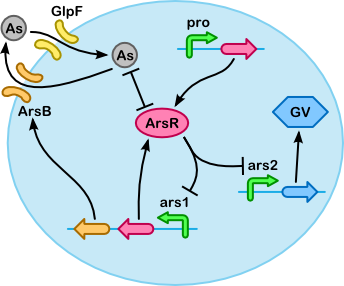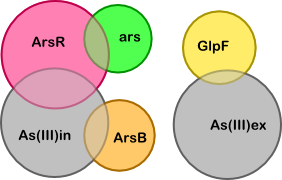Team:Groningen/Modelling/Arsenic
From 2009.igem.org
The raw model

The following variables play an important role in our system (these can be concentrations of substances, the density of the cell, etc.):
- Extracellular:
- As(III)ex
- Membrane (all naturally occurring, but we plan to bring GlpF to overexpression):
- GlpF (concentration w.r.t. the exterior of the cell)
- GlpFAs (concentration w.r.t. the exterior of the cell)
- ArsB (concentration w.r.t. the interior of the cell)
- ArsBAs (concentration w.r.t. the interior of the cell)
- Intracellular (ars2, pro and GV are introduced):
- As(III)
- ars1 (concentration of unbound promoters naturally occurring in E. coli)
- ars2 (concentration of unbound promoters in front of gas vesicle genes)
- pro (concentration of constitutive promoters in front of arsR)
- ArsR ArsR binds to ars to repress production of the genes they regulate, and binds to As(III) to make it less of a problem for the cell.i
- ArsRAs (bound to As(III))
- ArsRars1 (bound to ars1)
- ArsRars2 (bound to ars2)
- GV (concentration of gas vesicles)
The variables above can be related to each other through the following "reactions" (color coding is continued below to show which parts of the differential equations refer to which groups of reactions):
- Transport (based on Rosen1996, Meng2004 and Rosen2009)
- As(III)ex + GlpF ↔ GlpFAs
- GlpFAs → GlpF + As(III)
- As(III) + ArsB ↔ ArsBAs
- ArsBAs → ArsB + As(III)ex
- ArsB → null (degradation)
- Accumulation (based on Chen1997)
- As(III) + ArsR ↔ ArsRAs
- ars1 + 2 ArsR ↔ ArsRars1
- ars2 + 2 ArsR ↔ ArsRars2
- ars1 → ars1 + ArsR + ArsB (transcription + translation)
- ars2 → ars2 + GV (transcription + translation)
- pro → pro + ArsR (transcription + translation)
- ArsR → null (degradation)
- GV → null (degradation)
Resulting in the following differential equations (please note that some can be formed by linear combinations of the others), using color coding to show the correspondence to the reactions above:
- (d/dt) As(III)ex = - (d/dt) GlpFAs - k6 GlpFAs + (Vc/Vs) k8 ArsBAs
- (d/dt) GlpF = - (d/dt) GlpFAs
- (d/dt) GlpFAs = k5on As(III)ex GlpF - (k5off+k6) GlpFAs
- (d/dt) ArsB = - (d/dt) ArsBAs + β4 ars1 - ln(2)/τB ArsB
- (d/dt) ArsBAs = k7on As(III) ArsB - (k7off+k8) ArsBAs
- (d/dt) As(III) = - (d/dt) ArsRAs - (d/dt) ArsBAs - k8 ArsBAs + (Vs/Vc) k6 GlpFAs
- (d/dt) ars1 = - (d/dt) ArsRars1
- (d/dt) ars2 = - (d/dt) ArsRars2
- (d/dt) ArsR = β1 ars1 + β3 pro - (ln(2)/τR) ArsR - (d/dt) ArsRAs - 2 (d/dt) ArsRars1 - 2 (d/dt) ArsRars2
- (d/dt) ArsRAs = k1on ArsR As(III) - k1off ArsRAs
- (d/dt) ArsRars1 = k3on ArsR² ars1 - k3off ArsRars1
- (d/dt) ArsRars2 = k3on ArsR² ars2 - k3off ArsRars2
- (d/dt) GV = β5 ars2 - ln(2)/τG GV
Using the following constants/definitions:
| Name | Units | Description |
|---|---|---|
| k1on, k2on, etc. | 1/(M·s) | Reaction rate constants for reactions to a complex. |
| k1off, k2off, etc. | 1/s | Reaction rate constants for reactions from a complex. |
| k6, k8 | 1/s | Reaction rate constants representing how fast transporters transport their cargo to "the other side". |
| K1d - K4d | M | Dissociation constants. |
| τB, τR, τG | s | Half-lifes (of ArsB, ArsR and GV, respectively). Degradation rate = ln(2)/τ If you take just the degradation into account you will have the equation dC/dt = -k*C, which leads to C(t) = C(0) e-k t. So if k = ln(2)/τ we get C(t) = C(0) e-ln(2)/τ t = C(0) 2-t/τ. In other words τ is the time it takes for the concentration to half. i |
| β1, β2, etc. | 1/s | Production rates.
|
| Vs | L | Volume of solution (excluding cells). |
| Vc | L | Total volume of cells (in solution) (so Vs+Vc is the total volume). |
| v5, v7 | mol/(s·L) | Maximum reaction rates per liter of cells (see Michaelis-Menten equation). Note that we have purposefully chosen to write the units as mol/(s·L) instead of M/s, to emphasize the fact that it the rates are per liter of cells.
|
| v7'·ars | Reaction rate when As(III) = K7
| |
| K5, K7 | M | Concentration at which the reaction reaches half its maximum reaction rate (see Michaelis-Menten equation).
|
See Chen1997 for the interplay between ArsR and ArsD (the latter has a role similar to ArsR, but we do not treat it, as it is not present in our system).
Quasi-steady-state

When there are many molecules "waiting" to be transported and/or the concentrations in the cell and outside the cell are relatively slow changing compared to it is not unreasonable to assume that the amount of bound transporters is constant. Similarly, within the cell we assume diffusion processes are very fast and binding/unbinding of substances is quite fast compared to the production of proteins. This leads us to assume that the following ratios between substances are constantly in equilibrium:
As(III)ex : GlpFAs GlpF : GlpFAs ArsB : ArsBAs As(III) : ArsRAs : ArsBAs ArsR : ArsRAs : 2 ArsRars ars : ArsRars
Here we use the following to simplify the equations involving the ars promoters:
arsT = ars + ArsRars ars1 / ars1T = ars2 / ars2T ars = ars1 + ars2 ars = ars1 (1 + ars2T / ars1T) ars1 = ars / (1 + ars2T / ars1T) ars1 = ars ars1T / arsT ars2 = ars ars2T / arsT (d/dt) ArsR = β1 ars ars1T/arsT + β3 pro - (ln(2)/τR) ArsR - (d/dt) ArsRAs - 2 (d/dt) ArsRars (d/dt) GV = β5 ars ars2T/arsT - ln(2)/τG GV
To determine what these ratios are we can set the following derivatives to zero (these are the derivatives of the complexes corresponding to the four overlapping regions in the diagram):
0 = (d/dt) GlpFAs = k5on As(III)ex GlpF - (k5off+k6) GlpFAs 0 = (d/dt) ArsBAs = k7on As(III) ArsB - (k7off+k8) ArsBAs 0 = (d/dt) ArsRars = k3on ArsR² ars - k3off ArsRars 0 = (d/dt) ArsRAs = k1on ArsR As(III) - k1off ArsRAs
The first two derivates let us determine the ratios between bound and unbound transporters:
0 = (d/dt) GlpFAs = k5on As(III)ex GlpF - (k5off+k6) GlpFAs
k5on As(III)ex GlpF = (k5off+k6) GlpFAs
GlpF = (k5off+k6)/k5on GlpFAs / As(III)ex
GlpF = K5 GlpFAs / As(III)ex
GlpF : GlpFAs
K5 GlpFAs / As(III)ex : GlpFAs
K5 : As(III)ex
As(III)ex : GlpFAs
As(III)ex : GlpF As(III)ex / K5
1 : GlpF / K5
0 = (d/dt) ArsBAs = k7on As(III) ArsB - (k7off+k8) ArsBAs
k7on As(III) ArsB = (k7off+k8) ArsBAs
ArsB = (k7off+k8)/k7on ArsBAs / As(III)
ArsB = K7 ArsBAs / As(III)
ArsB : ArsBAs
K7 ArsBAs / As(III) : ArsBAs
K7 : As(III)
The other two differential equations can be used to determine the relative abundances of ArsR, ArsRAs and ArsRars (the latter is counted twice as ArsR binds to ars as a dimer):
0 = (d/dt) ArsRAs = k1on ArsR As(III) - k1off ArsRAs
k1on ArsR As(III) = k1off ArsRAs
ArsRAs = k1on/k1off ArsR As(III)
ArsRAs = ArsR As(III) / K1d
0 = (d/dt) ArsRars = k3on ArsR² ars - k3off ArsRars
k3on ArsR² ars = k3off ArsRars
ArsRars = k3on/k3off ArsR² ars
ArsRars = ArsR² ars / K3d
ArsR : ArsRAs : 2 ArsRars
ArsR : ArsR As(III) / K1d : 2 ArsR² ars / K3d
1 : As(III) / K1d : 2 ArsR ars / K3d
ars : ArsRars
ars : ArsR² ars / K3d
1 : ArsR² / K3d
And finally the relative abundances of arsenic:
ArsB = K7 ArsBAs / As(III) ArsBAs = ArsB As(III) / K7 ArsRAs = ArsR As(III) / K1d As(III) : ArsRAs : ArsBAs As(III) : ArsR As(III) / K1d : ArsB As(III) / K7 1 : ArsR / K1d : ArsB / K7
Summarizing:
As(III)ex : GlpFAs = 1 : GlpF / K5 GlpF : GlpFAs = K5 : As(III)ex ArsB : ArsBAs = K7 : As(III) As(III) : ArsRAs : ArsBAs = 1 : ArsR / K1d : ArsB / K7 ArsR : ArsRAs : 2 ArsRars = 1 : As(III) / K1d : 2 ArsR ars / K3d ars : ArsRars = 1 : ArsR² / K3d
Now we can look at the differential equations for the totals of ArsB (so ArsBT=ArsB+ArsBAs), ArsR, As(III) and As(III)ex (GlpFT and arsT are assumed to be constant):
(d/dt) As(III)exT = (d/dt) As(III)ex + (d/dt) GlpFAs
= - (d/dt) GlpFAs - k6 GlpFAs + (Vc/Vs) k8 ArsBAs + (d/dt) GlpFAs
= - k6 GlpFAs + (Vc/Vs) k8 ArsBAs
(d/dt) ArsBT = (d/dt) ArsB + (d/dt) ArsBAs
= - (d/dt) ArsBAs + β4 ars1 - ln(2)/τB ArsB + (d/dt) ArsBAs
= β4 ars1 - ln(2)/τB ArsB
(d/dt) As(III)T = (d/dt) As(III) + (d/dt) ArsRAs + (d/dt) ArsBAs
= - (d/dt) ArsRAs - (d/dt) ArsBAs - k8 ArsBAs + (Vs/Vc) k6 GlpFAs + (d/dt) ArsRAs + (d/dt) ArsBAs
= - k8 ArsBAs + (Vs/Vc) k6 GlpFAs
(d/dt) ArsRT = (d/dt) ArsR + (d/dt) ArsRAs + 2 (d/dt) ArsRars
= β1 ars1 + β3 pro - (ln(2)/τR) ArsR - (d/dt) ArsRAs - 2 (d/dt) ArsRars + (d/dt) ArsRAs + 2 (d/dt) ArsRars
= β1 ars1 + β3 pro - (ln(2)/τR) ArsR
Transport
By looking at the system in equilibrium we can more easily assess the impact of parameters and derive formulas for obtaining them. To this end we consider the system when all derivatives are zero (just taking the equations relevant for transport):
0 = (d/dt) As(III)ex = -k5on As(III)ex GlpF + k5off GlpFAs + (Vc/Vs) k8 ArsBAs 0 = (d/dt) GlpF = -k5on As(III)ex GlpF + (k5off+k6) GlpFAs 0 = (d/dt) GlpFAs = k5on As(III)ex GlpF - (k5off+k6) GlpFAs 0 = (d/dt) ArsB = -k7on As(III) ArsB + (k7off+k8) ArsBAs + β4 ars - ln(2)/τB ArsB 0 = (d/dt) ArsBAs = k7on As(III) ArsB - (k7off+k8) ArsBAs 0 = (d/dt) As(III) = -k7on As(III) ArsB + k7off ArsBAs + (Vs/Vc) k6 GlpFAs
The third equation is equivalent to the second and the fifth can be eliminated from the fourth, leading to:
0 = -k5on As(III)ex GlpF + k5off GlpFAs + (Vc/Vs) k8 ArsBAs 0 = -k5on As(III)ex GlpF + (k5off+k6) GlpFAs 0 = β4 ars - ln(2)/τB ArsB 0 = k7on As(III) ArsB - (k7off+k8) ArsBAs 0 = -k7on As(III) ArsB + k7off ArsBAs + (Vs/Vc) k6 GlpFAs
By combining the last two equations a rather obvious equation can be derived that essentially expresses that the import rate equals the export rate:
0 - 0 = (-k7on As(III) ArsB + k7off ArsBAs + (Vs/Vc) k6 GlpFAs)
+ ( k7on As(III) ArsB - (k7off+k8) ArsBAs)
0 = (Vs/Vc) k6 GlpFAs - k8 ArsBAs
k8 ArsBAs = (Vs/Vc) k6 GlpFAs
Using the equations above (and the fact that the total amount of importers doesn't change in our model) GlpFAs can be expressed as follows (working towards a Michaelis-Menten equation):
k5on As(III)ex GlpF = (k5off+k6) GlpFAs
GlpF = GlpFAs (k5off+k6) / (k5on As(III)ex)
GlpFT = GlpF + GlpFAs
GlpFT = GlpFAs (1 + (k5off+k6) / (k5on As(III)ex))
GlpFAs = GlpFT / (1 + (k5off+k6) / (k5on As(III)ex))
GlpFAs = GlpFT As(III)ex / (As(III)ex + K5)
Without ArsB regulation
If we disregard ArsB regulation ArsBAs can be determined similarly to GlpFAs:
ArsBAs = ArsBT As(III) / (As(III) + K7)
By substituting the above equations for GlpFAs and ArsBAs we can now derive a relation between the extracellular and intracellular concentrations of arsenic (where we recognize the constants of the well-known Michaelis-Menten equation):
k8 ArsBAs = (Vs/Vc) k6 GlpFAs
k8 ArsBT As(III) / (As(III) + K7) = (Vs/Vc) k6 GlpFT As(III)ex / (As(III)ex + K5)
v7 As(III) / (As(III) + K7) = v5 As(III)ex / (As(III)ex + K5)
v7 As(III) (As(III)ex + K5) = v5 As(III)ex (As(III) + K7)
As(III) (v7 As(III)ex + v7 K5 - v5 As(III)ex) = v5 K7 As(III)ex
As(III) = v5 K7 As(III)ex / (v7 As(III)ex + v7 K5 - v5 As(III)ex)
As(III) = v5 K7 As(III)ex / ((v7 - v5) As(III)ex + v7 K5)
An important flaw in this model is that the production of ArsB is dependent on the concentration of arsenic in the cell (via regulation by ArsR, see our transport page). This could be one of the reasons that this model is unable to fit the curve shown in figure 3A in Kostal2004 (if we try a least squares fit with the equation above, filling in v5 and K5 from what we computed for figure 1B in Meng2004, we get negative values for v7 and K7). (And something similar is true of figure 1 from Singh2008.) This led us to consider the regulation of ArsB, as is described in the following section.
With ArsB regulation
As explained above ArsBAs needs a slightly different approach, as ArsB can be produced in response to arsenic ArsBT is not a (known) constant and we have a formula dependent on ars instead:
β4 ars = ln(2)/τB ArsB
ArsB = (β4 τB/ln(2)) ars
(k7off+k8) ArsBAs = k7on As(III) ArsB
(k7off+k8) ArsBAs = (β4 τB/ln(2)) ars k7on As(III)
ArsBAs = (β4 τB/ln(2)) ars (k7on/(k7off+k8)) As(III)
ArsBAs = (β4 τB/ln(2)) ars As(III) / K7
This now leads to the following relation between intra- and extracellular As(III), note that v7' (in contrast to v7) is not the maximum export rate (it has units of 1/second):
k8 ArsBAs = (Vs/Vc) k6 GlpFAs
k8 (β4 τB/ln(2)) ars As(III) / K7 = (Vs/Vc) k6 GlpFT As(III)ex / (As(III)ex + K5)
v7'/K7 ars As(III) = v5 As(III)ex / (As(III)ex + K5)
As(III) = v5/(v7' ars) K7 As(III)ex / (As(III)ex + K5)
To get rid of the unknown ars in this equation we can use two equations that are derived below for accumulation:
0 = β1 ars + β3 pro - (ln(2)/τR) ArsR
(ln(2)/τR) ArsR = β1 ars + β3 pro
ArsR = (β1 ars + β3 pro) (τR/ln(2))
ars = arsT/(1 + ArsR²/K3d²)
arsT = (1 + ArsR²/K3d²) ars
arsT = ars + ArsR² ars / K3d²
0 = K3d² ars + ArsR² ars - K3d² arsT
0 = K3d² ars + (β1 ars + β3 pro)² (τR/ln(2))² ars - K3d² arsT
0 = K3d² ars + (β1 ars + β3 pro) (β1 ars² + β3 pro ars) (τR/ln(2))² - K3d² arsT
0 = K3d² ars + β1 ars β1 ars² (τR/ln(2))² + β1 ars β3 pro ars (τR/ln(2))² + β3 pro β1 ars² (τR/ln(2))² + β3 pro β3 pro ars (τR/ln(2))² - K3d² arsT
0 = β1² (τR/ln(2))² ars³ + 2 β1 β3 (τR/ln(2))² pro ars² + (β3² (τR/ln(2))² pro² + K3d²) ars - K3d² arsT
According to Mathematica's solution of Reduce[eq && K3d > 0 && arsT >= 0 && pro >= 0 && β1 > 0 && β3 > 0 && τR > 0, ars, Reals] (where eq is the equation above) there is only one real root, so we solve the equation safely using Newton's (or Halley's) method.
Accumulation
For many purposes, like determining the total amount of accumulated arsenic, it can be quite useful to consider the system in equilibrium. That is, when the derivatives of all variables to time are zero (just taking the equations relevant for accumulation here, assuming the As(III) concentration to be constant):
0 = (d/dt) ArsR = β1 ars + β3 pro - (ln(2)/τR) ArsR - (d/dt) ArsRAs - 2 (d/dt) ArsRars 0 = (d/dt) ArsRAs = k1on ArsR As(III) - k1off ArsRAs 0 = (d/dt) ArsRars = k3on ArsR² ars - k3off ArsRars
By eliminating the last two equations from the first and dividing the last two by k?on we are left with:
0 = β1 ars + β3 pro - (ln(2)/τR) ArsR 0 = ArsR As(III) - K1d ArsRAs 0 = ArsR² ars - K3d² ArsRars
Using the fact that the "concentration" of operators remains constant the last equation can be used to derive an equation for ars:
0 = ArsR² ars - K3d² ArsRars
ArsRars = ars ArsR² / K3d²
arsT = ars + ArsRars
arsT = ars + ars ArsR² / K3d²
arsT = ars (1 + ArsR²/K3d²)
ars = arsT/(1 + ArsR²/K3d²)
This leads to the following:
0 = β1 ars + β3 pro - (ln(2)/τR) ArsR 0 = β1 arsT + (β3 pro - (ln(2)/τR) ArsR) (ArsR²/K3d² + 1) 0 = β1 arsT + β3 pro ArsR²/K3d² + β3 pro - (ln(2)/τR) ArsR³/K3d² - (ln(2)/τR) ArsR 0 = K3d² (τR/ln(2)) β1 arsT + (τR/ln(2)) β3 pro ArsR² + K3d² (τR/ln(2)) β3 pro - ArsR³ - K3d² ArsR 0 = ArsR³ - (τR/ln(2)) β3 pro ArsR² + K3d² ArsR - K3d² (τR/ln(2)) (β1 arsT + β3 pro)
According to Mathematica's solution of Reduce[eq && K3d > 0 && arsT >= 0 && pro >= 0 && β1 > 0 && β3 > 0 && τR > 0, ArsR, Reals] (where eq is the equation shown above) there is only one real solution, so we can find it safely using Newton's (or Halley's) method.
Analogously to the derivation of the equation for ars an equation can be derived for the fraction of unbound arsenic in the cell:
As(III)T = As(III) + ArsRAs As(III)/As(III)T = 1/(ArsR/K1d + 1)
 "
"
